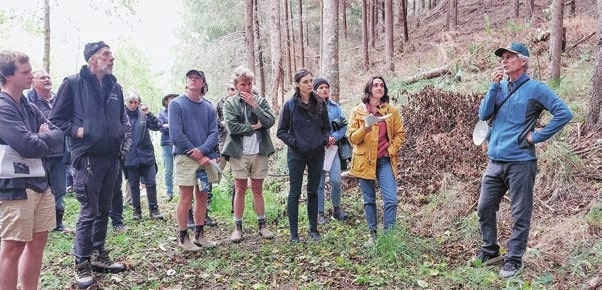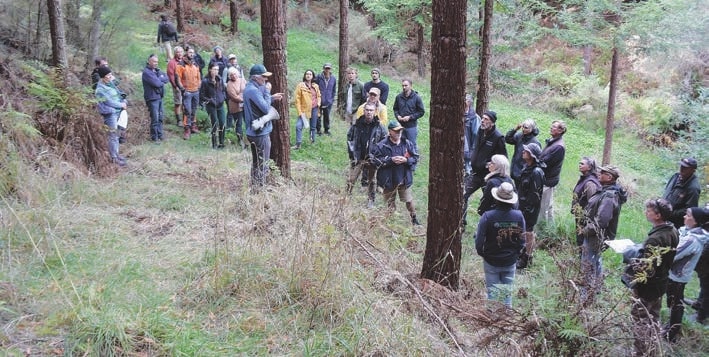Alternatives to pines field days
Dougal Morrison, New Zealand Tree Grower May 2024.
Field days covering growing trees on farms other than radiata pine are being run at many locations around the country by members of the NZFFA. The intention was to hold 20 of the ‘Alternatives to pines’ field days. The field days have been funded mainly by Te Uru Rakau – New Zealand Forest Service, along with significant input from NZFFA members.
Hopefully many of you will remember the article in the November Tree Grower in which this project was first aired. However, some of you may need a brief reminder.The idea was to use the field days to showcase
alternative tree species which have proved successful, and what they need in terms of location, climate, shelter, pest control and management. Each field day was to involve a short talk introducing the owner and the property, then a tour of the property explaining the reasons the trees were chosen, how they were planted, their survival and performance, the benefits they have provided, and the costs and expected.
The NZFFA branches who wanted to be involved would –
- Choose the location
- Find a speaker who knows about the species being discussed
- Show what has happened and how well it has gone
- Manage standard health and safety
- Provide tea and coffee and time for a chat.

The response from the branches to take part was very good, as we expected, and so far about half of the 20 field days have been completed. All of them have been well-attended with positive feedback from participants.
The field days are being run to share the experience of members about what grows well and where to plant. This is not only to encourage the use of alternative species for farm beautification, but also to try out alternative trees for commercial benefit.This includes the sale of wood, the use of timber on site, the control of hill country and stream bank erosion, and to provide shelter, shade and fodder for animals.
Many alternative species have desirable properties which radiata pine lacks.They can be decorative, stronger, harder, more stable, more free of defects, more readily workable or more naturally durable, and are in demand because of these characteristics. Most such material is imported and such imports cost New Zealand over $400 million a year. With the rising pressure to protect natural forests overseas, these supplies of imported wood are expected to become more expensive, which is one reason why it makes sense to grow more of these useful timbers locally.

Radiata pine comprises more than 90 per cent of New Zealand’s commercial forests.Therefore, there is a concern that we have almost ‘all our wood in one basket’. Pests or a disease could arrive and destroy most of it, or result in large costs to control them. Planting alternative species lowers the risk.
This is not to say that, alternative commercial species are not at risk from introduced pests and diseases as well. But they would be even more in demand, and their price would rise if there was a shortage of radiata pine.
Some work has already been carried out on the genetic selection for the productivity and disease resistance of alternative species. An example includes the control of poplar rust and this work is continuing.
Dougal Morrison is the coordinator of the field days.
 Farm Forestry New Zealand
Farm Forestry New Zealand